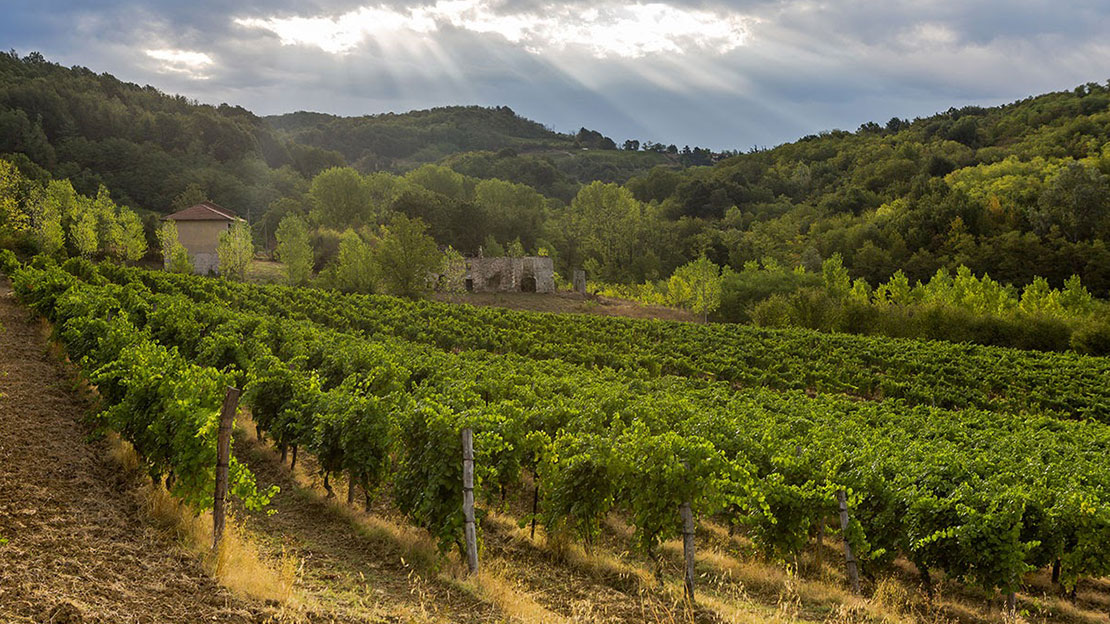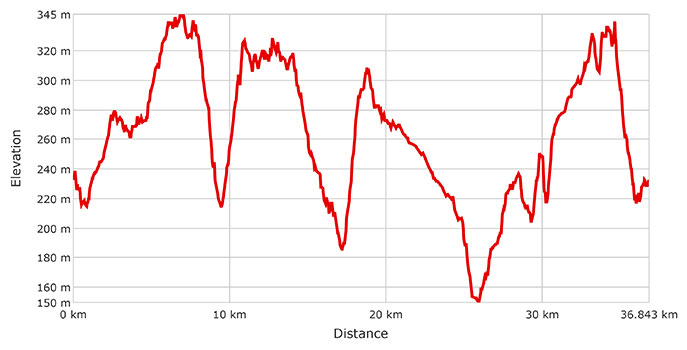
- Bike: strada/trekking
- Difficulty: ***
- Distance: 37 km
- Altitude difference: 195 m
- Total ascent: 717 m
- Total descent: 719 m

Gavi is a beautiful little town (awarded the prestigious Touring Club Italiano's orange flag) in the province of Alessandria, overshadowed by an old fort. It sits near the Ligurian-Piedmontese Apennines, surrounded by hills, and famous for its eponymous wine and the many wineries nearby.
Gavi is a town with ancient beginnings. Archaeology has unearthed man-made objects in smooth stone, dating from more than 2,000 years ago. The town's name probably comes from the Neolithic settlement Cavatium, from which the Latin Gavium. It is thought that Gavi was the capital of a Roman garrison defending Via Postumia, a consular road linking the river ports of the Empire, from Aquileia to Genoa. The first official document to mention the town is from the year 972 and today is kept in the state archives of Genoa.
Gavi's historic fort is a defensive structure built by the Genoese over an existing medieval castle. The first definite historical facts about the fort date back to the year 1000. It is now owned by the State and houses a museum.
Gavi is surrounded by a host of medieval villages, each with its own baronial castle or fort on a rocky precipice, and each nestled in a landscape of vineyards and patchy woodlands. Its great history and wines are the inspiration for this bike route, which lets you discover the area at your own pace, while tickling your taste buds and mind with knowledge and flavours.
The route begins in Piazza Dante, in Gavi, where you find a large car park. Go up Via Voltaggio and then right over the river Lemme. Once you've passed the bridge, turn left onto the SP 170 in the direction of Bosio. Pass the village of Alice and after 4.6 km, turn right onto Strada Val Pagani, at the top of which you find Bosio's giant bench on your right. It's the first of its kind in the Lemme valley and offers visitors a glimpse of the vineyards that yield Gavi, Cortese di Gavi and Dolcetto grapes. Go right towards Parodi Ligure and you reach the hamlet of Cadimassa, the highest point on the route at 345 m.
After a stretch of about 1 km, go down to Cadepiaggio and, once you're out of the village, we recommend a stop at the monastery of San Remigio on your right, which is more than a thousand years old. Leave the monastery behind and carry on along the SP 168, passing Parodi Ligure; if you're not in a hurry, stop for a meander through the streets of this ancient village. Get back on your bike and over to the hamlet of Cadegualchi. At the fork in the road, follow the signs for Tramontana. Once passed the parish church of the Natività, you reach San Cristoforo after 4 km. Do not miss the chance to stop and visit this village, with its historic centre, bejewelled by a beautiful castle surrounded by a small park. The elegant building is distinguished by an unusual polygonal tower, known as the Tower of the Gazzolo, built between the tenth and eleventh centuries.
Once out of the village centre, carry on along Strada Rondanino and then Strada Parodine, until you reach the village of Giora, near Capriata d’Orba. This is a scenic road about 5 km long, with rows of vines on both sides.
Turn right onto the SP 178, over the river Lemme once more, and go downhill to Francavilla Bisio. Once you reach the village gates, enjoy the impressive views of the castle overlooking it. The present structure is the result of continuous expansions and restorations of the tower, that dates back to the 10th century.
Continue along the municipal road to Tassarolo, and just before the village, on your left, you see the castle of Spinola, now home to a big wine producing business that still uses traditional methods. They are unique nowadays, employing horses and biodynamic agriculture to produce prestigious, certified organic wines.
This circular route is almost to an end. After the last village return to the historic centre of Gavi by following the road signs along the SP 159, then the SP 158 for about 7 km, surrounded all the way back by hills and Gavi and Dolcetto vineyards.
